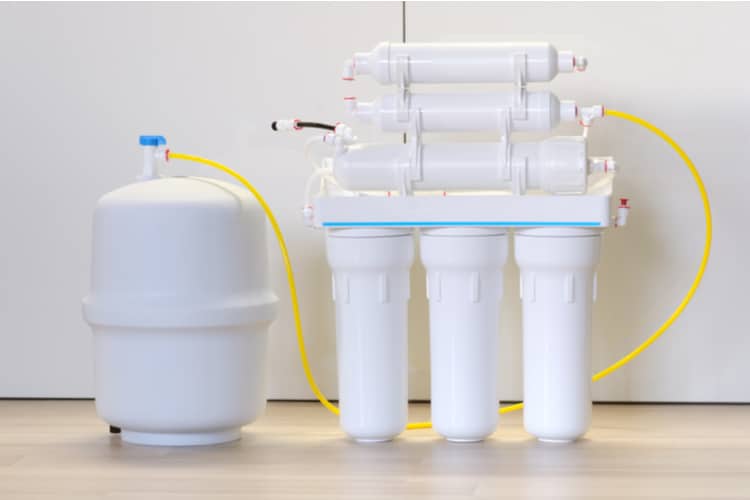PFAS (per- and polyfluoroalkyl substances) “forever chemicals” contamination in water can cause several health issues such as high cholesterol, kidney and testicular cancer, asthma, and thyroid disease. So, it is therefore important to filter PFAS from your drinking water with either reverse osmosis or granulated activated carbon water filtration technology.
Do brita filters remove pfas? The answer is no. Although Brita’s faucet, Elite, and Longlast+ filters can effectively remove most water contaminants, they cannot filter PFAS “forever chemicals”.
Why Brita Can’t Filter PFAS
Brita filters can’t remove PFAS because they don’t use any of the recognised methods of removing PFAS from water, such as reverse osmosis or Granulated activated carbon (GAC). Instead, they use a combination of one or more of these three methods: activated carbon block (for impurities such as taste, odor, and color), mesh media (for sediments), and a non-woven filter (for health hazards regulated by the EPA).
For Brita to effectively remove PFAS, they need to adopt one of the following water filtration technologies:
- Reverse osmosis (RO): Reverse osmosis is one of the most effective water filtration technologies, and that’s why it’s so popular in household water treatment units. Reverse osmosis removes PFAS thanks to the 0.0001-micron semi-permeable membrane in RO systems. This membrane traps PFAS and other contaminants, thereby allowing only clean water to pass through the membrane. The trapped PFAS is then flushed and released as waste water.
- Granular activated carbon (GAC): Granular activated carbon is an upgrade on the conventional activated carbon block water filtration method. While the carbon is in a compressed and stable state in a conventional carbon block, GAC has granules of carbon that are loose inside the filter cartridge. This way, GAC allows for more contact time with water, resulting in more effective water treatment. A carbon block can only reduce aesthetic impurities and some chemicals like chlorine, but GAC can easily filter dangerous contaminants like volatile organic compounds (VOCs) and PFAS.

Brita Alternatives That Can Filter PFAS
So, what other options are available since Brita can’t filter PFAS?
Here are 4 water filtration systems that can filter PFAS:
- Clearly Filtered Water Pitcher: Clearly filtered water pitcher is one of the best options to filter PFAS. It uses Affinity filtration technology to filter 95% of PFAS in drinking water. Affinity technology works similar to GAC, only that it has a unique filter structure and a contaminant magnet for PFAS removal. Clearly filtered pitcher is backed by NSF certifications (NSF Standards 42, 53, 244, 401, and 473) to remove over 365 drinking water contaminants, the highest of any water filter pitcher.
- Springwell CF1 Whole House Filter: This whole house water filter is the best choice if you’re looking for a water filter system to filter PFAS across the entire house. Springwell CF1 uses 4 stages of catalytic carbon (the higher version of Granular activated carbon) filtration to remove 99.5% of PFAS in water.
- AquaTRU RO System: AquaTRU is the best choice to remove PFAS via reverse osmosis. It uses a 4-stage reverse osmosis filtration process to remove 97.5% of PFAS from water. AquaTRU has long-lasting filters that only needs to be changed after 600 gallons of filtered water.
- Big Berkey Water Filter: Berkey is one of the most interesting water filter brands because they don’t use conventional water filtration methods. Rather, they use their own proprietary filtration technology called Black Berkey Elements, which is a combination of micro-filtration, adsorption, and absorption. The Big Berkey water filter removes 99.9% of PFAS in drinking water.
A Comparison Table for Brita Alternatives That Removes PFAS
| Brita Alternatives | Amount of PFAS Removed | Filtration Technology | Product Type | Price |
|---|---|---|---|---|
| Clearly Filtered | 95% | Affinity Filtration Technology | Water pitcher | Check Price |
| Springwell CF1 | 99.5% | 4-stage filtration w/ flex bed, KDF, catalytic carbon, and sediment filter | Whole house filtration system | Check Price |
| AquaTru RO System | 97.5% | Reverse osmosis | Countertop RO system | Check Price |
| Big Berkey | 99.5% | Black Berkey Elements | Countertop water filter | Check Price |
Conclusion
Although Brita has 6 different types of water filters on offer, none of them is equipped with the necessary filtration technology to remove PFAS. You can only remove PFAS via reverse osmosis or granular activated carbon (GAC) water filtration technologies.
Thank you. This is very informative.